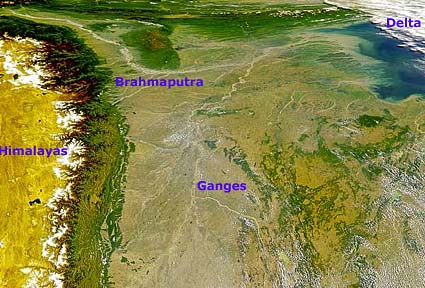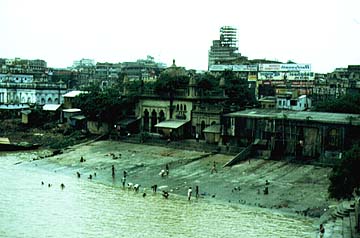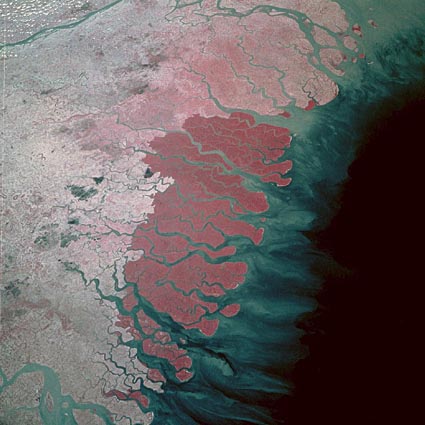|
Location: 23N 90E (Asia); length: 2500 kilometres (1600 miles); drainage basin: 1 million square kilometres (400,000 square miles).

The Ganges basin.
The Ganges, or Ganga, is one of Asia's largest rivers and sacred to followers of the Hindu religion. Unlike most other large Indian rivers, which rise on the northern slopes of the Himalayas, the Ganges rises from an ice cave on the southern slopes. From here it flows steeply down to reach the North Indian Plain and then flows out to the Gulf of Bengal. The main tributary of the Ganges is the Yamuna. A dam at Harwar diverts water for hydroelectric power that is used to pump water to irrigate the fields between the Ganges and Yamuna that are too high for gravity irrigation. The flow in the Ganges varies sharply throughout the year, almost ceasing at the end of the dry season and becoming a raging torrent in the monsoon. It is heavily silt laden when in flood, and it is this sediment that actively builds the delta into the Gulf of Bengal. The Ganges shares a deltaic region with the Brahmaputra. The largest distributary of the Ganges is the Padma which flows southeast until it joins the Jamuna, the main distributary of the Brahmaputra. The whole delta is some 400 kilometres (250 miles) from apex to the Gulf and 300 kilometres (200 miles) east-west. However, because the dominant distributaries carry the bulk of the water to the eastern end of the delta, the western end no longer receives fresh supplies of fertile sediment and so is 'dying' and the soils are poor and require fertilizer. The Hoogley is a western distributary of the Ganges in the dying part of the delta. Calcutta is situated on the Hoogley. The Farraka Barrage on the Ganges is designed to divert water to the Hoogley, and so reduce the silting in the Hoogley and improve navigation for Calcutta, but because this reduces the supply of water reaching Bangladesh, there is a conflict over water use. The delta fringe is partly protected by mangrove swamps, although these are being cleared as pressure on the land increases. The Ganges is an important river in the beliefs of the Hindu Religion, and it is known as the sacred Ganges. All along the banks of the Ganges there are flights of steps to allow the faithful to reach the river and bathe in the waters. These steps are called ghatts. The bodies of Hindus are also dipped in the Ganges before being cremated. The sacred city of Varanasi (Benares) lies on the banks of the Ganges, but the only major industrial city is Allahabad.

The River Hoogley, one of the distributaries of the Ganges, at Calcutta.

Mouths of the Ganges River, India and Bangladesh. South of the confluence of the Ganges and Brahmaputra Rivers (not shown in this photograph) and north of the Bay of Bengal lies the vast Ganges Delta plain, approximately 350 kilometres (220 miles) wide. Parts of the delta (the world's largest) lie in both Bangladesh and the State of West Bengal, India. In this low-oblique, infrared photograph, the deep reds of healthy vegetation register the Sundarbans, an abundant mangrove swamp that is the largest remaining habitat of the Bengal tiger. The entire region is plagued almost yearly by severe storm surges and powerful low-pressure cyclones that arrive from the Bay of Bengal. Although death and destruction follow in the wake of these storms, the resilient survivors continue to cultivate crops of rice, sugar cane, and jute.
|